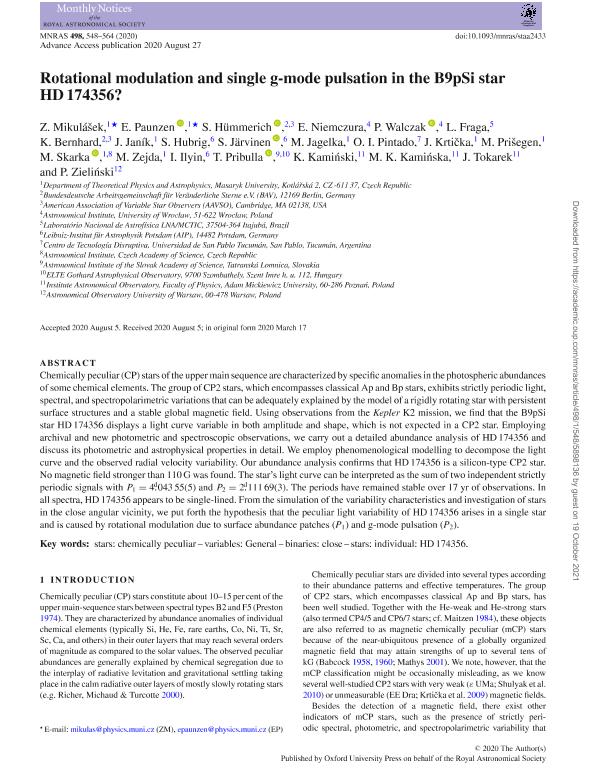Mostrar el registro sencillo del ítem
dc.contributor.author
Mikulaek, Z
dc.contributor.author
Paunzen, E.
dc.contributor.author
Hümmerich, S.
dc.contributor.author
Niemczura, E.
dc.contributor.author
Walczak, P.
dc.contributor.author
Fraga, L.
dc.contributor.author
Bernhard, K.
dc.contributor.author
Janik, J.
dc.contributor.author
Hubrig, S.
dc.contributor.author
Järvinen, S.
dc.contributor.author
Jagelka, M.
dc.contributor.author
Pintado, Olga Ines

dc.contributor.author
Krticka, J.
dc.contributor.author
Prisegen, M.
dc.contributor.author
Skarka, M.
dc.contributor.author
Zejda, M.
dc.contributor.author
Ilyin, I.

dc.contributor.author
Pribulla, T.
dc.contributor.author
Kaminski, K.
dc.contributor.author
Kaminska, M. K.
dc.contributor.author
Tokarek, J.
dc.contributor.author
Zielinski, P.
dc.date.available
2021-10-19T12:39:16Z
dc.date.issued
2020-10
dc.identifier.citation
Mikulaek, Z; Paunzen, E.; Hümmerich, S.; Niemczura, E.; Walczak, P.; et al.; Rotational modulation and single g-mode pulsation in the B9pSi star HD 174356?; Wiley Blackwell Publishing, Inc; Monthly Notices of the Royal Astronomical Society; 498; 1; 10-2020; 548-564
dc.identifier.issn
0035-8711
dc.identifier.uri
http://hdl.handle.net/11336/144218
dc.description.abstract
Chemically peculiar (CP) stars of the upper main sequence are characterized by specific anomalies in the photospheric abundances of some chemical elements. The group of CP2 stars, which encompasses classical Ap and Bp stars, exhibits strictly periodic light, spectral, and spectropolarimetric variations that can be adequately explained by the model of a rigidly rotating star with persistent surface structures and a stable global magnetic field. Using observations from the Kepler K2 mission, we find that the B9pSi star HD 174356 displays a light curve variable in both amplitude and shape, which is not expected in a CP2 star. Employing archival and new photometric and spectroscopic observations, we carry out a detailed abundance analysis of HD 174356 and discuss its photometric and astrophysical properties in detail. We employ phenomenological modelling to decompose the light curve and the observed radial velocity variability. Our abundance analysis confirms that HD 174356 is a silicon-type CP2 star. No magnetic field stronger than 110 G was found. The star's light curve can be interpreted as the sum of two independent strictly periodic signals with and. The periods have remained stable over 17 yr of observations. In all spectra, HD 174356 appears to be single-lined. From the simulation of the variability characteristics and investigation of stars in the close angular vicinity, we put forth the hypothesis that the peculiar light variability of HD 174356 arises in a single star and is caused by rotational modulation due to surface abundance patches (P1) and g-mode pulsation (P2).
dc.format
application/pdf
dc.language.iso
eng
dc.publisher
Wiley Blackwell Publishing, Inc

dc.rights
info:eu-repo/semantics/openAccess
dc.rights.uri
https://creativecommons.org/licenses/by-nc-sa/2.5/ar/
dc.subject
BINARIES: CLOSE
dc.subject
STARS: CHEMICALLY PECULIAR
dc.subject
STARS: INDIVIDUAL: HD 174356
dc.subject
VARIABLES: GENERAL
dc.subject.classification
Otras Ciencias Naturales y Exactas

dc.subject.classification
Otras Ciencias Naturales y Exactas

dc.subject.classification
CIENCIAS NATURALES Y EXACTAS

dc.title
Rotational modulation and single g-mode pulsation in the B9pSi star HD 174356?
dc.type
info:eu-repo/semantics/article
dc.type
info:ar-repo/semantics/artículo
dc.type
info:eu-repo/semantics/publishedVersion
dc.date.updated
2021-10-18T15:43:47Z
dc.journal.volume
498
dc.journal.number
1
dc.journal.pagination
548-564
dc.journal.pais
Reino Unido

dc.journal.ciudad
Londres
dc.description.fil
Fil: Mikulaek, Z. Masaryk University; República Checa
dc.description.fil
Fil: Paunzen, E.. Masaryk University; República Checa
dc.description.fil
Fil: Hümmerich, S.. Masaryk University; República Checa
dc.description.fil
Fil: Niemczura, E.. University of Wrocław; Polonia
dc.description.fil
Fil: Walczak, P.. University of Wrocław; Polonia
dc.description.fil
Fil: Fraga, L.. Masaryk University; República Checa
dc.description.fil
Fil: Bernhard, K.. American Association of Variable Star Observers ; Estados Unidos
dc.description.fil
Fil: Janik, J.. Masaryk University; República Checa
dc.description.fil
Fil: Hubrig, S.. Leibniz-Institut für Astrophysik Potsdam; Alemania
dc.description.fil
Fil: Järvinen, S.. Masaryk University; República Checa
dc.description.fil
Fil: Jagelka, M.. Leibniz Institute For Astrophysics Potsdam; Alemania
dc.description.fil
Fil: Pintado, Olga Ines. Consejo Nacional de Investigaciones Científicas y Técnicas. Centro Científico Tecnológico Conicet - Tucumán. Instituto Superior de Correlación Geológica. Universidad Nacional de Tucumán. Facultad de Ciencias Naturales e Instituto Miguel Lillo. Departamento de Geología. Cátedra Geología Estructural. Instituto Superior de Correlación Geológica; Argentina. Universidad San Pablo Tucumán; Argentina
dc.description.fil
Fil: Krticka, J.. Masaryk University; República Checa
dc.description.fil
Fil: Prisegen, M.. Masaryk University; República Checa
dc.description.fil
Fil: Skarka, M.. Masaryk University; República Checa
dc.description.fil
Fil: Zejda, M.. Masaryk University; República Checa
dc.description.fil
Fil: Ilyin, I.. Leibniz-Institut für Astrophysik Potsdam; Alemania
dc.description.fil
Fil: Pribulla, T.. Masaryk University; República Checa
dc.description.fil
Fil: Kaminski, K.. Adam Mickiewicz University; Polonia
dc.description.fil
Fil: Kaminska, M. K.. Adam Mickiewicz University; Polonia
dc.description.fil
Fil: Tokarek, J.. Adam Mickiewicz University; Polonia
dc.description.fil
Fil: Zielinski, P.. Astronomical Observatory University of Warsaw; Polonia
dc.journal.title
Monthly Notices of the Royal Astronomical Society

dc.relation.alternativeid
info:eu-repo/semantics/altIdentifier/doi/http://dx.doi.org/10.1093/mnras/staa2433
dc.relation.alternativeid
info:eu-repo/semantics/altIdentifier/url/https://academic.oup.com/mnras/article/498/1/548/5898136
Archivos asociados
